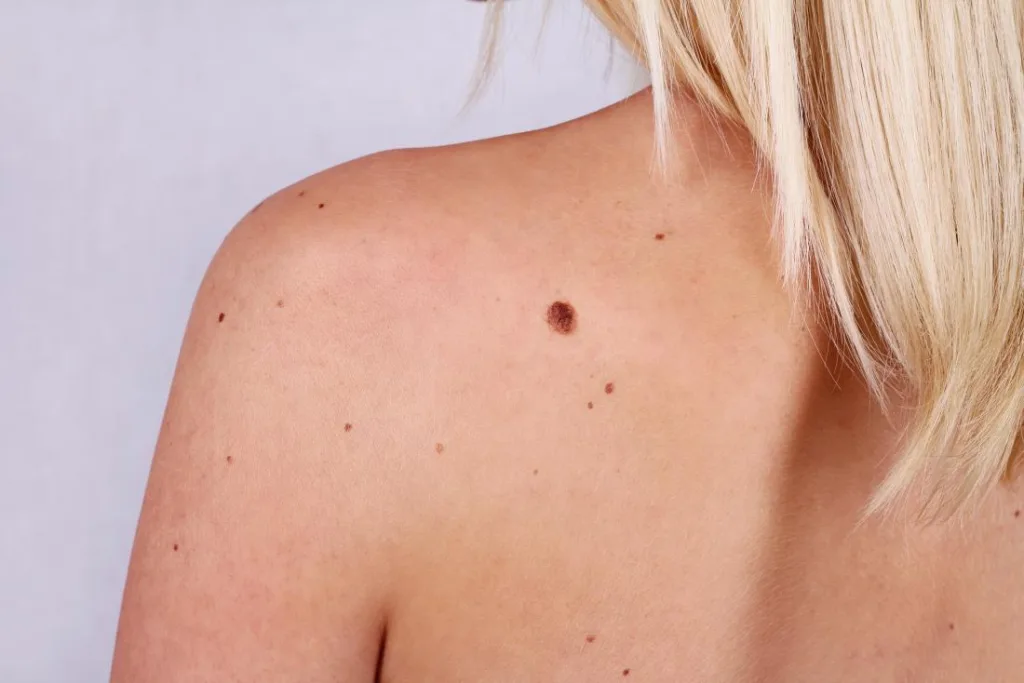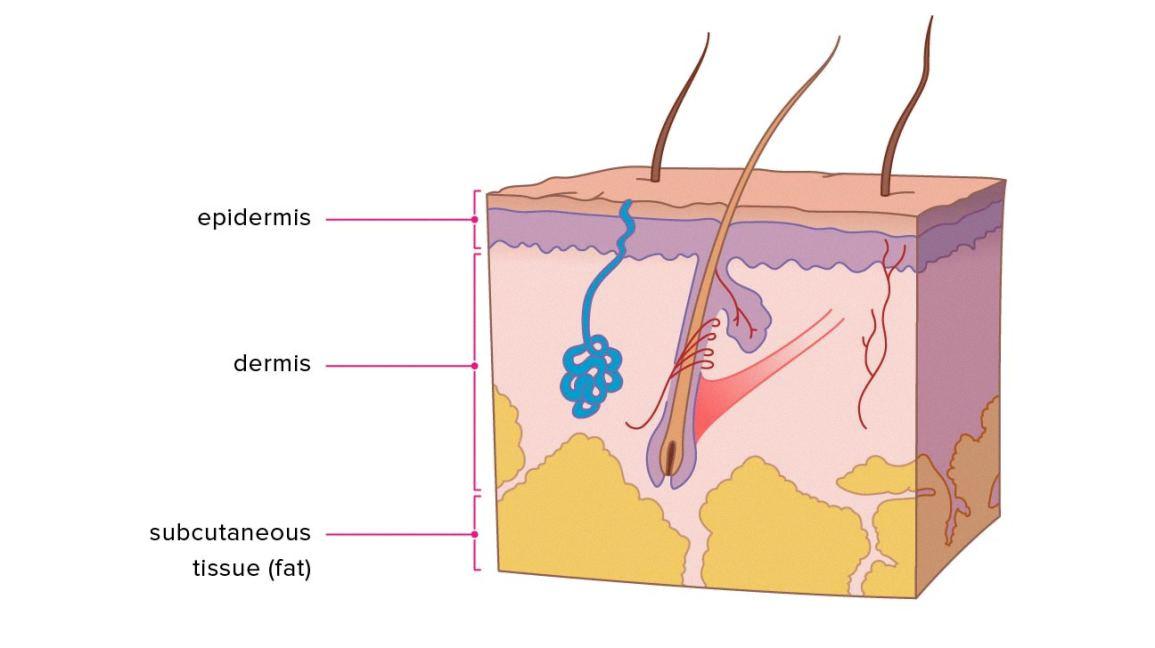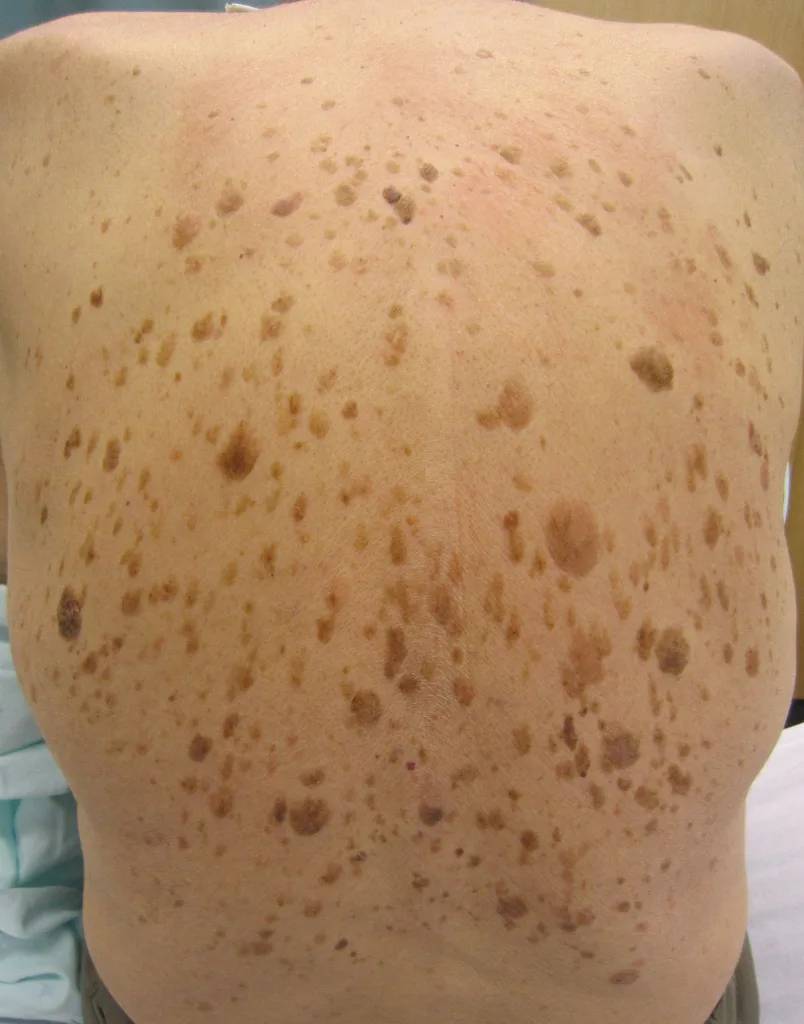Have you ever seen a strange spot on your skin and wondered what it was? It could be a barnacle. Barnacles are small, raised spots that can appear anywhere on the skin. They can vary in color from white to black, with yellows and many shades of brown in between.
Barnacles are also known as seborrheic keratoses, or “Seb Kers” for short. They typically appear as velvety or warty-looking growths stuck on the skin. While they may look like warts, barnacles are not contagious and should not cause any discomfort or pain.
Although the exact cause of barnacles is unknown, experts believe that genetic factors play a role. In other words, if your parents had them, then you may too. They usually develop slowly over time and can become more pronounced with age.
If you notice any strange spots on your skin, it’s best to have them checked out by a doctor or dermatologist. Treatment options include freezing with liquid nitrogen (cryotherapy), scraping (curettage) or shaving the surface of the skin, and burning with an electric current (electrocautery).
Barnacles may not cause any health problems but they can be unsightly and embarrassing for some people who want to get rid of them. Fortunately there are treatment options available that can help reduce ther appearance and make you feel more comfortable in your own skin again.
The Causes of Barnacles on Human Skin
Barnacles of aging are small, rough patches of skin that appear on the face and other parts of the body as we age. These spots are caused by a combination of genetics and sun exposure. The areas where they appear tend to be those that have been exposed to sunlight the most over time. They start as slightly raised, light brown spots which gradually thicken and darken until they present a rough, wart-like appearance. Although the color changes are harmless, it is important to protect youself from prolonged sun exposure in order to slow down the development of barnacles on your skin.

Removing Barnacles from the Body
Removing barnacles on your body generally requires professional medical assistance. Cryotherapy, which involves freezing the growth with liquid nitrogen, is a common method of removing tese benign skin lesions. Scraping (curettage) or shaving the skin’s surface can also be used to remove barnacles. In some cases, burning with an electric current (electrocautery) may be recommended by your doctor to help get rid of these growths. Whatever method is chosen, it is important to ensure that the entire lesion has been removed, as any remaining tissue can lead to recurrence.
Appearance of Barnacles on Humans
Barnacles on humans are small, raised spots that typically have a velvety or warty texture. They can vary in color from white, to black, to yellow and many shades of brown in between. They often appear “stuck on” to the skin and can be found almost anywhere on the body.
Are Skin Barnacles a Form of Cancer?
No, skin barnacles are not cancerous. They are also knon as Seb-Ks and are one of the most common noncancerous skin growths in older adults. They usually appear as slightly raised, skin colored or light brown spots and can have a waxy, scaly, warty texture. Seb-Ks are benign and do not spread to other parts of the body or cause any significant health problems. However, if you notice any changes in their size or shape, it is advisable to consult your doctor to rule out any other causes.
The Consequences of Touching a Barnacle
If you touch a barnacle, the sharp edges of its shells can easily cause cuts and scrapes on your skin. These cuts and scratches can become infected due to the barnacle’s foreign material. The infection can lead to an acute inflammatory process that can extend the wound-healing process. In some cases, it may take weeks or even months for the wound to heal completely. It is important to clean and cover the wound immediately with a bandage or antibiotic cream to help prevent infection.

Source: healthline.com
Removing a Seborrheic Keratosis: What to Expect
If you pick off a seborrheic keratosis, it can lead to bleeding, swelling and, in rare cases, infection. It can also cause the area to become irritated and sore which may be uncomfortable or painful. Picking at the lesion can also cause it to become inflamed and lead to scarring. To avoid any of these complications, it is best not to rub, scratch or pick at the lesions.
The Root Cause of Seborrheic Keratosis
The root cause of seborrheic keratosis is still not fully understood. It appears to have a genetic component, as it tends to run in families and those who have had one lesion are at an increased risk of developing more. It is not contagious or cancerous. The exact cause of this skin growth remains unknown, but research continues in order to better understand the underlying causes.
Preventing the Formation of Seborrheic Keratosis
There is no sure-fire way to prevent seborrheic keratoses from forming. However, if you are at risk or frequently develop these growths, working with a dermatologist can help ensure that the condition does not have an excessive impact on your life. Some lifestyle modifications that may reduce your risk of developing seborrheic keratoses include avoiding excess sun exposure, keeping your skin moisturized, and using sunscreen when outdoors. Additionally, your dermatologist may recommend topical treatments or laser therapy to remove existing growths and help prevent new ones from forming.
Removing Seborrheic Keratosis
Yes, it is possible to scrape off a seborrheic keratosis. The doctor will use either a tool or a laser to freeze and scrape off the growth. In some cases, the doctor may also use cryotherapy, which involves freezing the growth with liquid nitrogen. After the procedure, there may be a light or dark mark on the skin or even a scar. It is important to note that this treatment shuld only be performed if the seborrheic keratosis bothers you and you are sure of what you are getting into before proceeding.

Does Hydrogen Peroxide Treat Seborrheic Keratosis?
Yes, hydrogen peroxide can be used to remove seborrheic keratosis. The FDA has recently approved a 40% topical solution of hydrogen peroxide (Eskata – Aclaris Therapeutics) specifically for the treatment of raised SKs in adults. Hydrogen peroxide works by killing the abnormal skin cells that form the seborrheic keratosis and causing them to dry up and flake off. It is important to note that this higher concentration of hydrogen peroxide should only be used under the supervision of a healthcare professional and is not availale over-the-counter like 3% topical solutions.
Removing Seborrheic Keratosis at Home
At home, the best way to remove seborrheic keratosis is to see a healthcare provider who can use an FDA-approved topical solution of 40% hydrogen peroxide. The solution comes in an applicator pen, which your healthcare provider will apply several times in one visit. This method has been proven to be safe and effective in treating seborrheic keratosis. However, it is important to note that uing over-the-counter hydrogen peroxide solutions, which are only a 1% strength, is not recommended for removing seborrheic keratosis.
The Impact of Barnacle Removal on Marine Life
Removing barnacles from a turtle can be very painful and can cause damage to the turtle. It is best to leave them be if possible, as they naturally help protect the turtle from parasites and injuries. If removal is necessary, it should only be done by a professional, using specialized tools and techniques to prevent further injury or infection.
The Benefits of Exfoliating for Seborrheic Keratosis
Exfoliating can help to reduce the appearance of seborrheic keratosis. It helps to remove the dead skin cells that accumulate on the surface of the keratosis and can soften it, making it less noticeable. Exfoliating should be done gently and with caution sine vigorous rubbing can cause irritation, inflammation, and even bleeding. After soaking the affected area in a bath or swimming pool, use a rough object such as an exfoliating glove, pumice stone, emery board or fine sandpaper to gently rub away any buildup of dead skin cells. You may need to repeat this treatment several times for best results.
The Risk of Infection from Barnacles
Barnacles can cause infection, although it is uncommon. Barnacle infections typically occur when a person’s skin comes into contact with the shells of oysters or oher shellfish that are infected with the bacterium Vibrio parahaemolyticus. These bacteria can cause an infection known as Vibrio parahaemolyticus sepsis, which is characterized by fever, chills, diarrhea, and abdominal pain. In some cases, the infection may be severe enough to require hospitalization and intravenous antibiotics. Additionally, if the oyster bed is contaminated with sewage or other sources of pollution, then barnacles may also carry other bacteria such as E. coli and Salmonella that can also cause infections. It is important to take precautions when handling oysters and other shellfish by wearing gloves and proper protective clothing to avoid coming into contact with any potentially infectious agents.
Conclusion
In conclusion, barnacles of aging can occur in humans and are usually harmless. They start as slightly raised and light brown spots, gradually thickening until they present a rough and wart-like appearance. Although these growths typically do not cause any medical problems, freezing with liquid nitrogen, scraping, or burning with an electric current can be used to remove them if desired. It is important to note that the tendency to develop seborrheic keratoses is inherited and that they may darken over time.
